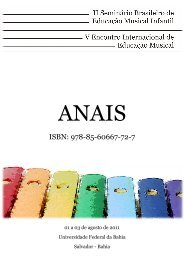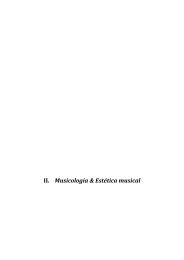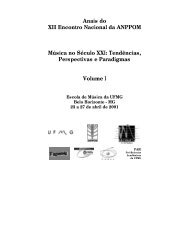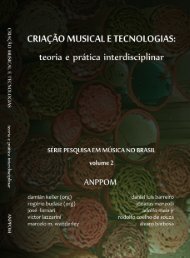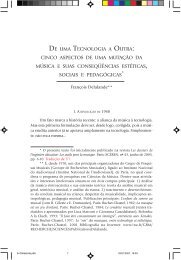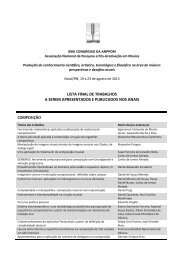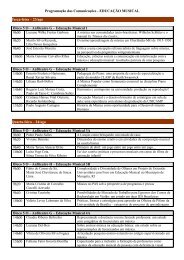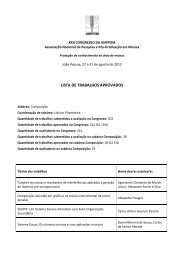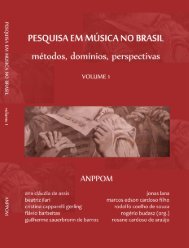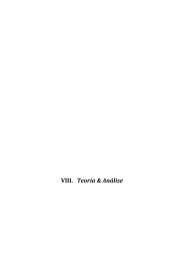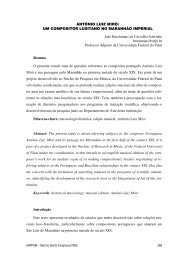download da versão impressa completa em pdf - anppom
download da versão impressa completa em pdf - anppom
download da versão impressa completa em pdf - anppom
You also want an ePaper? Increase the reach of your titles
YUMPU automatically turns print PDFs into web optimized ePapers that Google loves.
. . . . . . . . . . . . . . . . . . . . . . . . . . . . . . . . . . . . . . . . . . . . . . . . . . . . . . . . . . . . . . . . . . . . . . . . . . . . . . BARBOSA<br />
‘padrão central’ que permeie to<strong>da</strong> a obra de arte, propiciando uma espécie de<br />
homogenei<strong>da</strong>de interna, ser este ‘mecanismo’ o el<strong>em</strong>ento responsável pela geração de<br />
uni<strong>da</strong>de na obra. Parece melhor pensar sobre esta ‘substância musical idêntica’ como um<br />
el<strong>em</strong>ento interno que reforça na reali<strong>da</strong>de a necessi<strong>da</strong>de interna de que el<strong>em</strong>entos distintos<br />
sejam agregados ao conteúdo (impari<strong>da</strong>de não permite comparação). Ou seja, quanto<br />
maior a presença de um padrão específico, maior a necessi<strong>da</strong>de de mecanismos de<br />
oposição. Quando esse equilíbrio é desfeito, a uni<strong>da</strong>de interna <strong>da</strong> obra também é destruí<strong>da</strong>,<br />
o que faz com que o todo, <strong>em</strong> sua constituição interna, apresente probl<strong>em</strong>as de coerência<br />
ou de relação entre as partes.<br />
Assim, o que é uni<strong>da</strong>de ou o que propicia uni<strong>da</strong>de na obra de arte? Como foi<br />
visto, ca<strong>da</strong> período histórico, através dos seus pensadores e compositores, parece ter<br />
encontrado as ‘respostas’ para estes questionamentos. Contudo, como a própria palavra<br />
‘resposta’ – do Latin resposita, do v. reponêre, palavra constituí<strong>da</strong> por duas partes, ‘re’ que<br />
está relaciona<strong>da</strong> à idéia de repetição, retorno, e ‘pônêre’, que significa ‘por’ (CUNHA,<br />
2001) – sugere, apresentar uma resposta implica <strong>em</strong> ‘por’ a questão novamente, to<strong>da</strong>via o<br />
questionamento s<strong>em</strong> dúvi<strong>da</strong> reaparecerá <strong>em</strong> uma nova perspectiva. Portanto, apresentar<br />
uma resposta não significa manifestar uma solução definitiva, mas sim aquecer o debate para<br />
que novos pontos de vista possam surgir.<br />
Referências<br />
ABDO, Sandra Neves. Execução/Interpretação musical: uma abor<strong>da</strong>g<strong>em</strong> filosófica. Per Musi.<br />
Belo Horizonte, v.1, 2000, p. 16-24.<br />
BAKER, Nancy Kovaleff. Expression. In: SADIE, Stanley (ed). The New Grove Dictionary of<br />
Music and Musicians, v. 6, p. 324-327. London: Macmillan, 1980.<br />
CUNHA, Antônio Geraldo <strong>da</strong>. Dicionário Etimológico Nova Fronteira <strong>da</strong> Língua Portuguesa. 2<br />
ed. Rio de Janeiro: Nova Fronteira, 2001.<br />
GARCIA, Federico. Schoenberg and the Habsburg Dil<strong>em</strong>ma. A research program more than<br />
its conclusions. Disponível na internet <br />
JEPPESEN, Kund. Counterpoint: the polyphonic vocal style of the sixteenth century. New York:<br />
Dover, 1992.<br />
LECOAT, Gerard G. Comparative aspects of Theory of Expression in the Baroque age. In<br />
Eighteenth-Century Studies, V. 5, No. 2 (Winter, 1971-1972), p. 207-223.<br />
RETI, Rudolph. The th<strong>em</strong>atic process in Music. Oxford: Oxford University Press, 1961.<br />
ROSEN, Charles. Sonata forms. New York: W.W. Norton, 1988.<br />
opus. . . . . . . . . . . . . . . . . . . . . . . . . . . . . . . . . . . . . . . . . . . . . . . . . . . . . . . . . . . . . . . . . . . . . . . . . . . . . . 77



